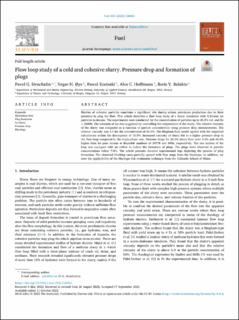Flow loop study of a cold and cohesive slurry. Pressure drop and formation of plugs
Struchalin, Pavel; Øye, Vegar Hovdenakk; Kosinski, Pawel Jan; Hoffmann, Alex Christian; Balakin, Boris
Journal article, Peer reviewed
Published version

Åpne
Permanent lenke
https://hdl.handle.net/11250/3028228Utgivelsesdato
2023Metadata
Vis full innførselSamlinger
Sammendrag
Slurries of cohesive particles constitute a significant risk during subsea petroleum production due to their potential to plug the flow. This article describes a flow loop study of a slurry consistent with 0.23-mm ice particles in decane. The experiments were conducted for the concentration of particles up to 20.3% vol. and Re 25000. The cohesion of ice was suggested by controlling the temperature of the slurry. The relative viscosity of the slurry was computed as a function of particle concentration using pressure drop measurements. The relative viscosity was 3.1 for the concentration of 20.3%. The Bingham-fluid model agreed with the empirical calculations within the discrepancy of 15.5%. Increased viscosity of slurry led to a higher pressure drop in the flow loop compared to the single-phase case. Pressure drops for 20.3% slurry flow were 5.2% and 44.4% higher than for pure decane at Reynolds numbers of 24778 and 4956, respectively. The test section of the loop was equipped with an orifice to induce the formation of plugs. The plugs were observed at particle concentrations below 7.0%. The article presents detailed experimental logs depicting the process of plug formation. The observed blocking cases partially agreed with flow maps from the literature. In addition, we note the applicability of the blockage risk evaluation technique from the Colorado School of Mines.
